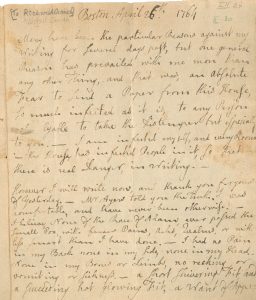by Dr. Talya Housman, Threadable Books
“I intend next week (Thursday) to be inoculated by Doctr. Joseph Gardner at Point Shirley…it would be a singular pleasure to me if you and I could be pockey Companions.”[1]
– Jonathan Sewall to John Adams, 15 February 1764.
We don’t have a response from Adams to his good friend Sewall’s offer to get inoculated together, but Adams did get inoculated against smallpox in April of 1764. What did the process of getting inoculated look like in 1764?
Adams’s inoculation did not look so different from our shots at the doctor’s office today. He described the process in a letter to Abigail: “Dr. Perkins demanded my left Arm and Dr. Warren my Brothers. They took their Launcetts and with their Points divided the skin for about a Quarter of an Inch and just suffering the Blood to appear, buried a Thread about a Quarter of an Inch long in the Channell. A little Lint was then laid over the scratch and a Piece of a Ragg pressed on, and then a Bandage bound over all.”[2]
Following the procedure, the patients would carefully monitor their symptoms to see if and how they developed smallpox. After five days of watching, Adams updated Abigail: “We have compleated five days, and entered two Hours on the sixth, since Innoculation, and have as yet felt no Pains, nor Languors from Pox or Medicine, worth mentioning. Indeed what the others have suffered is a mere Trifle.”[3]
However, only eight days later Adams explained that he had not written to Abigail for the last eight days due to “an Absolute Fear to send a Paper from this House, so much infected as it is, to any Person lyable to take the Distemper but especially to you.” Not only was Adams infected himself, but “every Room in the House, has infected People in it, so … there is real Danger, in Writing.”[4] Adams’s fear of sending mail might ring familiar to many of us frantically researching how long Coronavirus lives on paper vs. cardboard vs. plastic to see when we can interact with our mail, packages, and groceries.
Another familiar concern is infecting loved ones. “For all the Mountains of Peru or Mexico I would not,” Adams wrote to Abigail, “that this Letter or any other Instrument should convey the Infection to you at unawares.”[5]

Thankfully Adams developed, by both his own account and those of others, a light case which earned him immunity without too much pain.[6] He recovered quickly and returned to Braintree in early May. Abigail had missed Adams terribly. On hearing the news of Adams returning to Braintree, Abigail, then in Weymouth, wrote “Welcome, Welcome thrice welcome is Lysander [her nickname for Adams] to Braintree, but ten times more so would he be at Weymouth, whither you are afraid to come.—Once it was not so. May not I come and see you, at least look thro a window at you?”[7] Abigail’s desire to see Adams through a window mirrors the news stories of cranes raising people to look in on their loved ones at nursing homes and friends parking in cars next to each other to talk through their windows.
It’s been over 250 years since John Adams was inoculated against smallpox during the outbreak of 1764. Today we are faced not with smallpox, but with coronavirus. We do not yet have a vaccine, but we, like Abigail, miss our loved ones. We, like John Adams, fear passing contagion to our loved ones. We find ways to respond to crisis and disease that are not only despair, resourcefulness, and charity, but also, like Jonathan Sewall’s offer of “pockey companionship,” wit, camaraderie, and a bit of snark.
Dr. Housman’s first book project uses digital tools to explore sexual crime in seventeenth century England. She has written on numerous historical topics including slavery, suffrage, religious freedom, industrialization, charitable giving, and pandemics for various public history organizations.
[1] Jonathan Sewall to John Adams, 15 February 1764 in Papers of John Adams, Vol. 1. [link]
[2] John Adams to Abigail Smith, 13 April 1764 in Adams Family Correspondence, Vol. 1. [link]
[3] John Adams to Abigail Smith, 18 April 1764 in Adams Family Correspondence, Vol. 1. [link]
[4] John Adams to Abigail Smith, 26 April 1764 in Adams Family Correspondence, Vol. 1. [link]
[5] John Adams to Abigail Smith, 26 April 1764 in Adams Family Correspondence, Vol. 1. [link]
[6] John Adams to Abigail Smith, 26 April 1764 in Adams Family Correspondence, Vol. 1; Cotton Tufts to Abigail Smith, 19? April 1764 in Adams Family Correspondence, Vol. 1. [link]
[7] Abigail Smith to John Adams, 9 May 1764 in Adams Family Correspondence, Vol. 1. [link]

